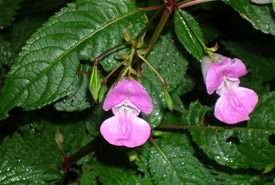
Himalayan balsam (Photo by Keith Williamson)
Policeman's helmet
Himalayan balsam, commonly known as policeman’s helmet, is an invasive alien species threatening wetlands throughout much of the northern hemisphere. While native to the Himalayas, this plant spreads aggressively along riverbanks.
This purple-flowered giant (it can grow to be more than two metres tall) hasn't been too much of a problem in North America yet, but it's gaining hold in many of Ontario's local watersheds. The main threat posed by this plant is against native vegetation. On many occasions, native plants are out-competed and often suffocated.
How is it identified?
The name "policeman’s helmet" comes from the flowers, which are shaped like a British policeman’s helmet. Similar in shape to Ontario’s native orange jewelweed, the flowers are pink, white or purple, with five irregular and asymmetrical petals.
The stem of this plant is usually purple with a reddish tinge. It is hollow and heavily branched. The leaves are egg-shaped with a serrated edge.
Where does it grow?
This plant is now present across much of the Northern Hemisphere and is found along rivers, trails and roadsides with moist to wet soils.
What does it threaten?
This plant spreads aggressively along riverbanks and may replace native perennials, possibly resulting in erosion. Significant nectar stores may draw native pollinators away from native flowers. Dense stands may exclude native plants and wildlife.
What is NCC doing to control this species?
It is a Nature Conservancy of Canada (NCC) stewardship priority to remove these plants, generally by hand. Because of its shallow roots, policeman’s helmet is easily pulled from moist soil.
This is a simple task, unless you arrive a little late in the year. By mid-to-late August, these plants start to set seed and the seeds are held in explosive pods, much like touch-me-nots. One touch, or even a stiff gust of wind, will cause the pod to burst, dispersing seeds many feet away from the parent plant. This is a great way to spread seeds around the landscape, but it is difficult to handle when you are trying to control the plant.
The work to remove policeman’s helmet should be completed before the fruits begin to ripen, and it may be necessary to continue the process over several years.
How can you help?
Everyone can help to win the battle against alien invasive species. Here are some ways you can help:
- Dispose of yard waste properly. Dumping yard waste in natural areas can introduce alien invasive species that will thrive and spread. Even leaf piles can be problematic, as dumped piles can smother native vegetation. Contact your municipality to find out how to dispose of yard waste properly.
- Plant native species in your garden. There are lots of beautiful native species that attract native butterflies and birds, making your garden twice as beautiful. Native species are also adapted to our climate and often require less rigorous care than exotic species.
- Report sightings of invasive plants to your local stewardship council. Finding these invasions early is key to eradicating them.
- Clean your shoes or bicycle tires when moving between designated trails in different areas. Invasive plants are often spread accidentally from seeds stuck in treads.




